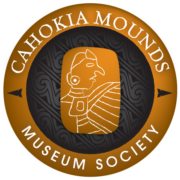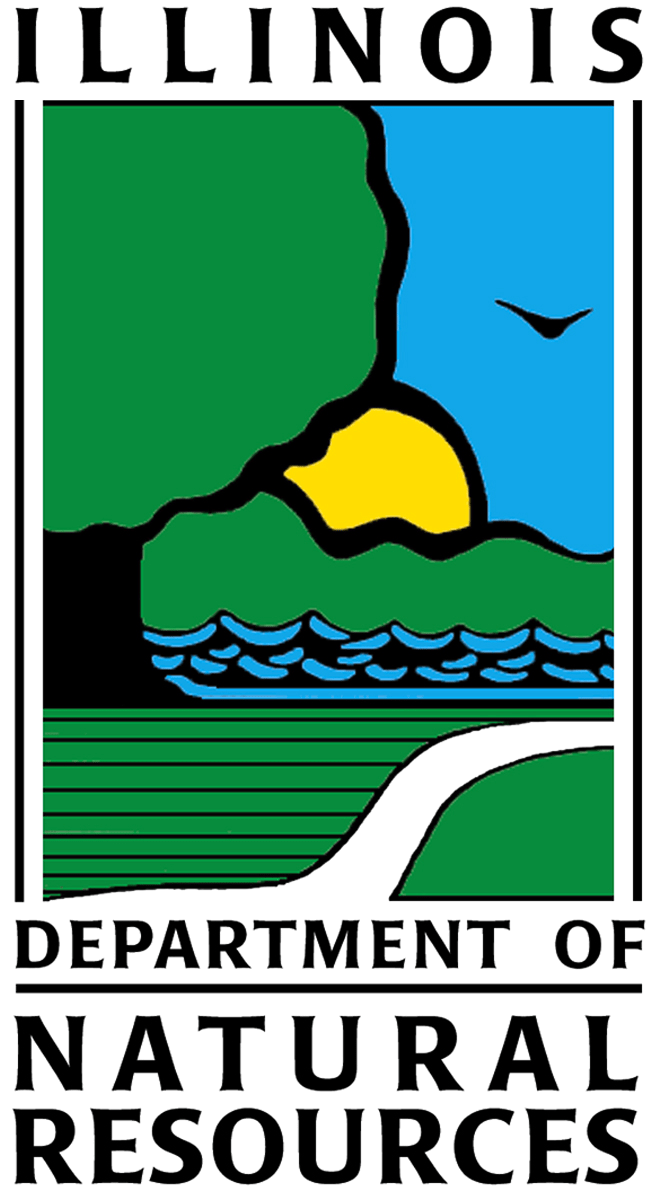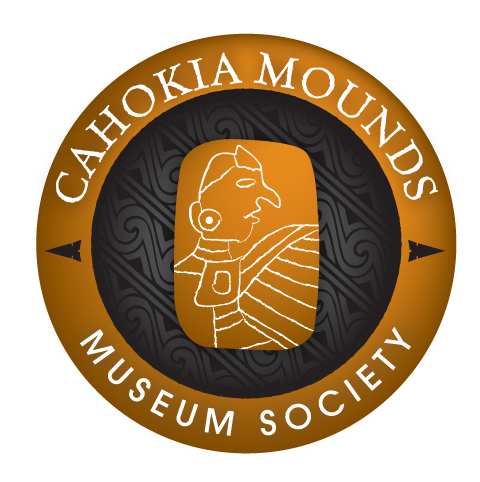At what is generally considered the western edge of the Cahokia site was a large, rectangular-based, ridge-topped mound that is known as the Powell Mound after the property owners in the 1930s. The Powell Mound is shown rather distinctly on the additional segment of the map made by Patrick and his surveyors in the late 1870s. Dr. Paul A. Titterington, the St. Louis physician and local archaeologist, saw the mound and later observed its destruction in the 1930s. He describes it as follows:
“This mound, Number 46 in the Moorehead classification, was 310 feet long, 180 feet wide and 40 feet high. It was the most symmetrical mound in the group and was shaped like a large Hayrick.” (Titterington 1938: 15)
Fortunately, the mound was still standing in 1922 when Lt. Goddard of the US Army Air Service took oblique photographs of the site (Goddard 1969; Hall 1968; Fowler 1977). One was a low oblique shot of Powell mound group. It shows the nature Mound 86 and its shape, which conforms very well with the description by Titterington.
Scaling data from the Patrick Map indicates a north-south dimension of 150 feet (45.7 meters) and an east-west dimension of 300 feet (91.4 meters). Moorehead gives a north-south dimension of 170 feet (51.8 meters) and an east-west dimension of 310 feet (94.5 meters). Various heights have been recorded for this mound: Patrick in 1876 indicates a height of 45 feet (13.7 meters); McAdams in 1882, 30 feet (9.1 meters); Thomas in 1894, 35 feet (10.7 meters); Peterson-McAdams in 1906, 30 feet (9.1 meters); and Moorehead in 1929, 40 feet (12.2 meters). The dimensions are rather consistent, indicating an unchanging size through time. Given Titterington’s description and early photos, it appears that the mound had retained its primary form.
Because of its outstanding form and shape, the Powell Mound has been photographed and illustrated in many publications (Bushnell 1902: Figure 104: Moorehead 1929: Plate 39; Titterington 1938: Figures 35, 46, 48, 50 and 51).
As discussed at several points in this atlas, Moorehead referred to the Powell Mound as Mound 46, whereas Patrick did not number it and used 46 for another mound. It is unfortunate that the numbering for this mound is confused. I feel it important to maintain Patrick’s number 46 for the mound he intended it to represent, which is still partially preserved under the fill of the Interstate 55-70 (see discussion of Mound 46). Therefore, the number 86 has been assigned to the Powell Mound. However, those working at the site in the 1930s followed Moorehead’s lead, thus in much of the literature it is referred to as Mound 46.
Unfortunately, the Powell Mound was partially destroyed in 1930 and 1931. Titterington describes the event:
In December of 1930 and January of 1931, all but 5 feet of its base was removed, the object being to fill in an area of low ground 200 to 400 yards to the northwest. By doing this, the owners were able to put their whole tract of about 50 acres under cultivation.
It is regrettable that information from this mound was almost completely lost to science. The loss was due to lack of funds by the scientific institutions, and to the lack of public interest. For a period of several years the Powell brothers had a standing offer of $3,000 and 3 years time open to any institution that cared to study the mound; the only conditional requirement was that the dirt removed be placed in an area of low ground 200 to 400 yards away. The undertaking was too big for those scientifically interested, even with the financial assistance offered by the owners. It seems that the state wanted to buy the mound with a 50 foot margin around the base and a road leading to the main highway. This proposition did not appeal to the Powells because it would have taken a mushroom-shaped piece out of one end of their tract of land. They offered to sell their whole farm, but this in turn did not appeal to the state. With this deadlock, there were rumors of condemnation proceedings which precipitated the removal of the mound.
Work was started on the north side of the mound with a large steam shovel, which was hidden from the view of the highway by the large size of the mound. It was eight days before the public was aware that the mound was being taken down. At this time the Powells gave permission for a scientific man to watch the proceedings, and do what excavating he could as long as he did not interfere with the contractor.
This work was under the supervision of the Archaeological Department of the University of Illinois, but did not get underway until the razing had been in progress for a total of 16 days. [Titterington 1938: 13-14]
A. R. Kelly, then of the University of Illinois at Champaign-Urbana, observed the mound’s destruction. In February, 1931, Thorne Deuel, of the University of Chicago and representing the University of Illinois, conducted excavations into the remaining base of the Powell Mound, or about 5 feet (1.5 meters) of the original mound. Kelly observed:
Notes and photographs taken on the profile through the long axis of the large Powell mound by Dr. L. E. Worktnan of the State Geological Survey during the course of mound removal by steam shovel in 1930, indicate that the mound was constructed in two stages, and consisted of a top layer of mound earth about 1S20 feet in height, brought to an apex in a hogback ridge running along the greater axis of the mound, and underlying an original mound core which is approximately 27 feet high. The older mound was of the rectangular, flattopped variety familiar in the Cahokia area. No burials or burial furniture were found in the basal mound structure, and the pot sherds and artifacts contained there in were evidently chance inclusions made while the mound builders were obtaining the baskets of mound earth from adjacent camp and village sites.
Later a second mound was built over the original flat-topped structure, but first the mound builders made two unique burial plots on the surface of the basal mound. The first of these burials plots was destroyed by steam shovel: The second was hand trowelled by a member of the University staff and adequate notes were taken. The long bones and skulls of several secondary interments had been placed between alternating sheaths of cedar bark with a blanket or shell covering the bones. A thin cornhusk or grass mattinghad covered the whole burial plot, approximately 18-20 feet in diameter. Two wooden spools covered with sheet copper, interpreted as ear pendants, fell from the burial level during excavation… Other burials found on the slopes of the mound were without burial furniture. No material of cultural significance was found in the upper 20 feet of the Powell Mound. [Kelly 1933: 101]
The materials excavated by Thorne Deuel are stored at the Illinois State Museum. Kelly briefly noted these materials:
Excavations made in February 1931, provided information as to the structure of the seven feet of mound material left at the base of the large mound destroyed by steam shovel. Beneath the mound were extensive village site remains, pot sherds, stone and bone artifacts, and kitchen refuse. The pottery in the underlying camp site was of the same or related type as that accidentally included in the earth used in the mound construction. [Kelly 1933: 101]
An analysis of the materials from Thorne Deuel’s excavations at the Powell Mound, including sherds, artifacts, and Deuel’s notes, was made by Steven Ahler and Peter DePuydt 1986. Ahler and DePuydt compiled an excavation profile of the north wall of the east-west trench excavated by Deuel. The mound section showed three units of cultural activity. There was a premound occupation of the area with ceramics predominately related to the Fairmount phase. A small mound or mound core appeared in the profile; and a later mound fill seems to have been added over the entire mound. The small mound or mound core appears to have been close to 20 feet (6.1 meters) in height. Ahler and Depuydt’s analysis of the sherds from the mound fill suggests a Stirling phase association for these activities. Considerable stone chipping debris was found in the premound deposits.
Titterington talked to some who were present when razing of the mound commenced, before A. R. Kelly started his work, and he gives a much more detailed description of the findings, stratigraphy, and construction of the mound. Instead of quoting extensively from this description, I refer the reader to Titterington’s 1938 publication, pages 14 and 15.
In the early 1960s the remaining portion of the Powell Mound was threatened by construction of a large discount store. The University of Illinois Archaeological Field School, under the direction of Charles Bareis, excavated into the base of the decimated Powell Mound, in the remnants of smaller mounds, and nearby areas.
The razing of the Powell Mound in the 1930s and construction of the Gem Store in the 1960s nearly completed Powell Mound’s destruction. Charles Bareis (personal communication) states:
The area of the Powell Mound (No.86) is not totally destroyed. Two or three feet of the mound base remains north of the Venture Store and the parking lot behind the store. In some areas the mound was stripped so low by work for the original Gem International, Inc. Store and parking lot area that the original pre-mound surface has been exposed… Perhaps the northern one third or… one half of the bottom two feet of the mound is still there.




